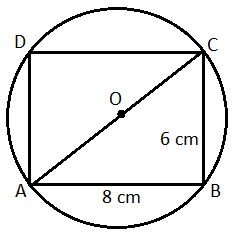Home > Practice > Arithmetic Aptitude > Area > Miscellaneous
91. The sides of a rectangle are 8 cm and 6 cm. The corners of the rectangle lie on a circle. Find the are a of the circle without the rectangle :
Radius = 5 cm
Required area = (Area of the circle) - (Area of the rectangle)

Solution:
Diameter of the circle :Radius = 5 cm
Required area = (Area of the circle) - (Area of the rectangle)

92. A can go round a circular path 8 times in 40 minutes. If the diameter of the circle is increased to 10 times the original diameter, then the time required by A to go round the new path once, travelling at the same speed as before, is :
Then, its circumference = metres
Time taken to cover m = 40 min
New diameter = m
Then, its circumference = m
∴ Time taken to go round it once :
Solution:
Let original diameter be d metreThen, its circumference = metres
Time taken to cover m = 40 min
New diameter = m
Then, its circumference = m
∴ Time taken to go round it once :
93. Area of a rectangle is 150 sq. metre. When the breadth of the same rectangle is increased by 2 metres and the length decreased by 5 metres the area of the rectangle decreases by 30 square metres. What is the perimeter of the square whose sides are equal to the length of the rectangle ?
Then area of the rectangle = ×
= 150 m2 . . . . . (i)
According to the question,
On solving both equations we get,
= 15 m and = 10 m
Side of square = length of rectangle (given)
So, the perimeter of the square :
= 4 ×
= 4 × 15
= 60 m
Solution:
Let the length of rectangle be metre and the breadth of the rectangle be metreThen area of the rectangle = ×
= 150 m2 . . . . . (i)
According to the question,
On solving both equations we get,
= 15 m and = 10 m
Side of square = length of rectangle (given)
So, the perimeter of the square :
= 4 ×
= 4 × 15
= 60 m
94. If the total surface area of a cube is 864 square cm, find the volume of the cube ?
∴ Total surface area of cube = 6a2
⇒ 6a2 = 864
⇒ a2 = = 144
⇒ a = = 12 cm
∴ Volume of cube :
= a3 cm3
= (12 × 12 × 12) cm3
= 1728 cm3
Solution:
Each edges of cube = a cm∴ Total surface area of cube = 6a2
⇒ 6a2 = 864
⇒ a2 = = 144
⇒ a = = 12 cm
∴ Volume of cube :
= a3 cm3
= (12 × 12 × 12) cm3
= 1728 cm3
95. A man is walking in a rectangular field whose perimeter is 6 km. If the area of the rectangular field be 2 sq. km, then what is the difference between the length and breadth of the rectangle ?
Then,
2 (l + b) = 6
⇒ l + b = 3
And lb = 2
(l - b)2 = (l + b)2 - 4lb
⇒ (l - b)2 = 32 - 4 × 2
⇒ (l - b)2 = 1
⇒ (l - b) = 1 km
Solution:
Let the length and breadth of the field be l and b km respectivelyThen,
2 (l + b) = 6
⇒ l + b = 3
And lb = 2
(l - b)2 = (l + b)2 - 4lb
⇒ (l - b)2 = 32 - 4 × 2
⇒ (l - b)2 = 1
⇒ (l - b) = 1 km
96. If the diagonal and the area of a rectangle are 25 m2 and 168 m2, what is the length of the rectangle ?
Then, breath of the rectangle =
Hence, length = 24 m and breadth = 7 m
Solution:
Let the length of the rectangle be x metres.Then, breath of the rectangle =
Hence, length = 24 m and breadth = 7 m
97. A path of uniform width runs round the inside of a rectangular field 38 m long 32 m wide. If the path occupies 600 m2, then the width of the path is :
Then,
Solution:
Let the width of the path be xThen,
98. The length and breadth of the floor of the room are 20 feet and 10 feet respectively. Square tiles of 2 feet length of different colours are to be laid on the floor. Black tiles are laid in the first row on all sides. If white tiles are laid in the one-third of the remaining and blue tiles in the rest, how many blue tiles will be there ?
Area under white tiles :
Area under blue tiles :
Number of blue tiles :
Solution:
Area left after laying black tiles :Area under white tiles :
Area under blue tiles :
Number of blue tiles :
99. Of the two square fields, the area of one is 1 hectare while the other one is broader by 1%. The difference in their areas is :
Side = m = 100 m
Side of the other square = 101 m
Difference in their areas :
= [(101)2 - (100)2] m2
= [(101 + 100) (101 - 100)] m2
= 201 m2
Solution:
Area = 1 hect. = 10000 sq. mSide = m = 100 m
Side of the other square = 101 m
Difference in their areas :
= [(101)2 - (100)2] m2
= [(101 + 100) (101 - 100)] m2
= 201 m2
Next